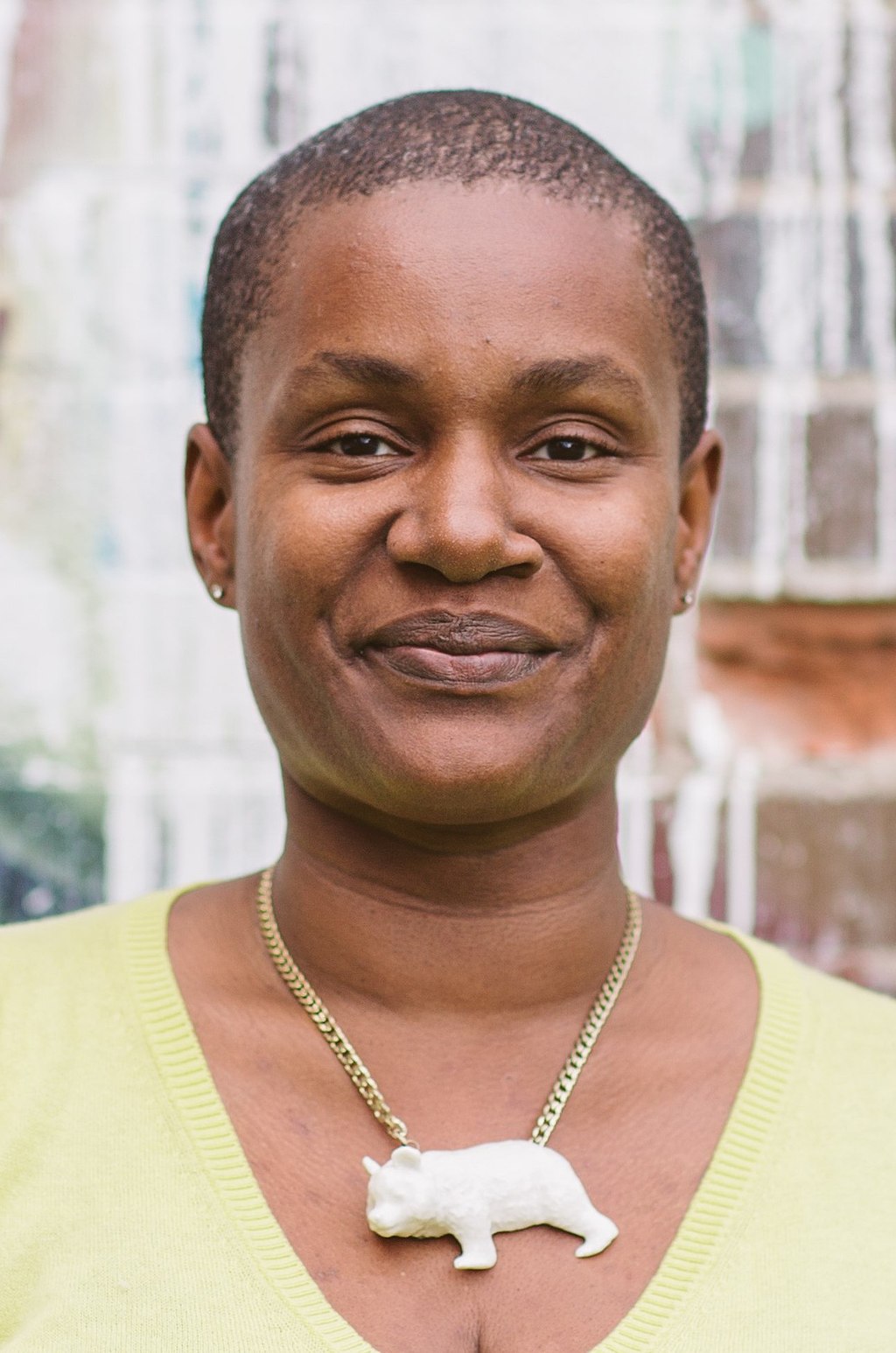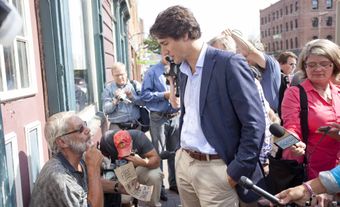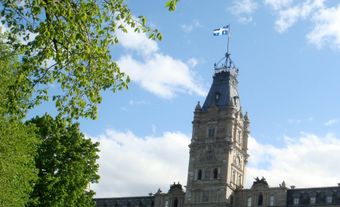The Green Party of Canada is a federal political party that advocates environmentalism as the key to a sustainable society. Annamie Paul was elected in 2020 to become the party’s leader, replacing Elizabeth May. Paul became the first Black Canadian and the first Jewish Canadian woman to permanently lead a federal political party. She resigned as leader after the party’s poor performance in the September 2021 federal election.
Two Green Party candidates were elected to the House of Commons in the 2021 election. (See Member of Parliament.)
Ideology
Founded in 1983, and inspired by the success of sister parties in New Zealand and Germany, the Green Party of Canada set out to replace the traditional left-versus-right political debate in favour of a new emphasis on protecting the environment and conserving natural resources. In 2002, the Green Party embraced the six fundamental principles of the Global Greens Charter: ecological wisdom; social justice; participatory democracy; non-violence; sustainability; and respect for diversity.
The party’s founding leader in Canada was Trevor Hancock, who led the organization from 1983 to 1984, followed by Seymour Trieger (1984–88), Kathryn Cholette (1988–90), Chris Lea (1990–96), Wendy Priesnitz (1996–97), Harry Garfinkle (1997), Joan Russow (1997–2001), Chris Bradshaw (2001–03), Jim Harris (2003–06), Elizabeth May (2006–19) and Annamie Paul (2020–21).
What Direction?
As environmental activism shifted from being the focus of mainly interest groups to the central concern of a new political party, questions arose: Where did the party fit on the political spectrum? Did it embrace a completely new ideology? How could it move beyond a single issue, towards a comprehensive policy outlook spanning a wide range of issues?

If the Green Party leaned to the left, how could it differentiate itself from the social democratic policies of the New Democratic Party? Many Green party supporters say that they are “neither left nor right,” but instead embrace an amalgam of socially progressive, fiscally conservative and environmentally green ideas. Elizabeth May, who became leader of the Green Party in 2006, guided the party in a more centrist direction.
Other key questions are whether party decision-making should be decentralized or centralized, and how Canada’s provincial Green parties could be coordinated with the national organization.
Early Struggles
The Green Party has run candidates in federal elections since 1984. The party presented fewer than 100 candidates in each of its first four elections. In 2004, under Jim Harris’s leadership, it ran a full slate of candidates for the first time in all 308 federal ridings.
The party has steadily improved its performance since that time. In 2004, it garnered more than 582,000 votes (4.3 per cent of total votes cast). In 2006, the party received more than 664,000 votes (4.5 per cent) — a disappointment for many members, who had hoped that under Elizabeth May’s higher-profile leadership the party might do considerably better. Two years later, however, in the 2008 election, the party increased its vote total to more than 937,000 (6.8 per cent).

2011 Federal Election
In the 2011 federal contest, the Greens’ vote total fell to 576, 221 (3.9 per cent). That disappointment was somewhat diminished, however, by Elizabeth May’s victory — winning a seat in the British Columbia riding of Saanich-Gulf Islands, and becoming the party’s first member of Parliament. Since then, May has been voted Parliamentarian of the Year in 2012 by her fellow MPs, Hardest Working MP of 2013, and Best Orator of 2014. May was joined in the House of Commons by a second federal representative in December 2013, when former MP Bruce Hyer left the New Democratic Party and joined the Greens.
2015 Federal Election
The 2015 election was a disappointment for the Greens, who had hoped to achieve continued growth. Elizabeth May was the only Green candidate elected in the country, and the party received 3.5 per cent of the popular vote, slightly less than its 2011 result.
2019 Federal Election
However, support for the Green Party rose in the lead-up to the federal election of October 2019. In May 2019, Paul Manly won a by-election in Nanaimo-Ladysmith on Vancouver Island, becoming the second MP elected under the Green Party banner. The same month, the Greens released Mission: Possible, their 20-step climate action plan. In August 2019, Elizabeth May announced a plan to help workers in the oil and gas industry transition to a renewable energy economy. In September 2019, polls showed the Greens in fourth place, only slightly behind Jagmeet Singh’s New Democratic Party.
At the heart of the party’s 2019 campaign platform were the virtual elimination of fossil fuel use and the development of a sustainable economy. This included continued opposition to pipeline expansion and the corresponding increase in tanker traffic. The Greens also proposed a comprehensive national climate and energy strategy, a carbon fee and dividend plan and the end of government subsidies to fossil fuel industries. In addition, the platform included implementing a national pharmacare plan and abolishing tuition fees for postsecondary students. The Green Party also promised more support for seniors, a Guaranteed Livable Income, an ongoing commitment to reconciliation with Indigenous peoples in Canada and renewed support for scientific research.
In late September, the party released a document that outlined the economic costs and benefits of its platform. However, some key party promises, such as phasing out oil sands production, were not included. Independent analyses by the Parliamentary Budget Officer (PBO) and Institute of Fiscal Studies and Democracy (IFSD) at the University of Ottawa questioned the accuracy and reliability of the Green Party’s numbers.
On 21 October 2019, the Greens won three seats — May and Manly were re-elected in their British Columbia ridings, while Jenica Atwin won in Fredericton, New Brunswick. It was the Green Party of Canada’s first victory in the Atlantic provinces. While this was a significant achievement, it was not the breakthrough many expected. Still, May was optimistic that the Party could make a “significant contribution” in the new Liberal minority government.
May resigned as party leader on 4 November 2019. She continues to sit as a Member of Parliament and to serve as the parliamentary caucus leader. Jo-Ann Roberts, a former journalist, was named interim leader.
2020 Leadership Convention
The Green Party’s leadership convention was held online, due to the COVID-19 pandemic, between 26 September and 3 October 2020. The number of party members eligible to vote — 34,680 — was almost 10 times the number of members that attended the last leadership election in 2006.
Annamie Paul, a human rights lawyer from Toronto, was elected leader of the Green Party over seven other candidates on the eighth ballot. She had previously finished fourth in Toronto Centre in the 2019 federal election. One of her first major actions as Green leader was to contest the riding once again in an October 2020 by-election prompted by the resignation of Bill Morneau. Paul garnered a surprising 32.7 per cent of the vote but still lost to Liberal Marci Ien.

Annamie Paul in Toronto's Regent Park during the 2019 Federal Election.
2021 Federal Election
In the months leading to the 2021 federal election, the Green Party experienced severe internal infighting. Some members were dissatisfied with Annamie Paul’s more muted position on the escalating Israeli-Palestinian conflict. Criticism intensified when Paul failed to reign in an adviser who openly called for defeating Green MPs deemed to be anti-Semitic. As a result, Paul’s leadership was seriously weakened. Party executives even tried to remove her as party leader and revoke her membership. One of the party’s three MPs, Jenica Atwin of Fredericton, crossed the floor and joined the Liberals.
Despite these difficulties, Paul remained party leader when Prime Minister Justin Trudeau called an election in late August 2021. During the election on 20 September, the party performed poorly. It elected two MPs, down from three in 2019. Mike Morrice won in Kitchener Centre and Elizabeth May won for the fourth time in Saanich-Gulf Islands. The Green Party’s national vote share also decreased from 6.5 per cent in 2019 to 2.3 per cent in 2021. Annamie Paul failed in her third bid to win election in Toronto Centre, after refusing to run in a more Green-friendly riding. A few weeks after the election, she resigned as party leader.
Provincial Progress
There are also provincial Green parties in most of Canada, and some have made important progress in recent elections. The Green Party of British Columbia won its first seat in the Legislature in the province’s 2013 election. In the 2017 provincial election, the Greens elected three candidates to the BC legislature. Since then, they have supported the minority NDP government under John Horgan in return for environmental concessions. In New Brunswick, the Greens won a single seat in 2014 and three seats in the 2018 provincial election. In 2015, the first Green candidate was elected to the Prince Edward Island legislature. In 2019, the party won eight seats in PEI and became the Official Opposition — a first for the Green Party. The party also won a seat in Ontario during the 2018 provincial election.
Challenges
The Green Party faces a number of hurdles in its quest to play a greater role in Canadian politics. The party is generally ignored by the other parties in Parliament; broadcasters sometimes exclude it from the major leaders’ television debates, and the electoral system does not translate votes into seats proportionally. More than six per cent of voters supported the party in 2019, yet it has fewer than one per cent of the MPs in the House of Commons. As a result, some Canadians are reluctant to cast a ballot for the party, since they feel it is a wasted vote. A more proportional electoral system would help the Greens significantly.
Despite these challenges, the Green Party has moved from being an obscure fringe party to a serious, if minor, player in Canadian politics, with seats in the House of Commons and in four provincial legislatures.

 Share on Facebook
Share on Facebook Share on X
Share on X Share by Email
Share by Email Share on Google Classroom
Share on Google Classroom






.jpg)


